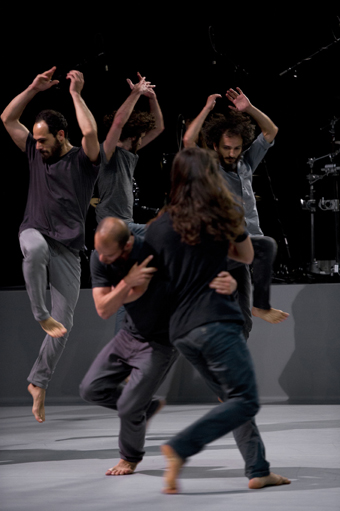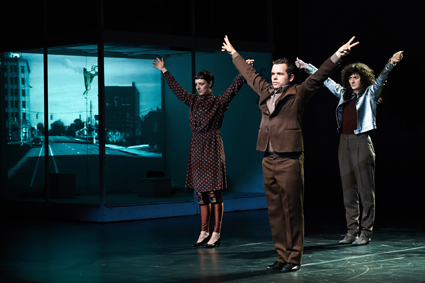Artistic greatness and human fallibility
Emi Foster: FTA, Festival TransAmériques, Montreal

D’Après Une Histoire Vraie, Christian Rizzo
photo Marc Domage
D’Après Une Histoire Vraie, Christian Rizzo
Works in this year’s Festival TransAmériques in Montreal appeared bound by the desire of each creator to express a strong thesis. In the dance program, three works in particular chose to tackle very clear concepts, from the validity of revering an artistic canon to the meaning of masculinity in today’s world. The following works shared an intense, almost relentless physicality and a total commitment to their conceptual investigation.
Christian Rizzo, D’Après Une Histoire Vraie
D’Après Une Histoire Vraie (Based on a True Story) takes its inspiration from a visit to Turkey 10 years ago, during which Rizzo witnessed Turkish folk dance. As such, the movement vocabulary for the work is drawn extensively from Rizzo’s research into traditional dances of the Middle East, the Magreb, France and Spain. He is incredibly adept at deconstructing the choreographic structures of these dances and rearranging them without diluting their original intent. The performers weave in and out of continually changing duets and trios to the rhythms of two drummers playing contemporary drum kits, revisiting not only the motifs of the dances they appropriate but also rock ’n’ roll tropes as they headbang, long hair and beards flying, to the driving beats.
With eight male dancers, the work is inherently an investigation into contemporary Western masculinity through juxtaposition of the handholding and physical closeness of folk dance, cultural stereotypes and stigmas around those, and the injection of hyper-masculine rock. Rizzo is a master of structure, pattern and timing, and at just over an hour the work is easy to watch, but it’s conceptually thin and needed to ask far more questions of itself.
Catherine Gaudet, Au Sein Des Plus Raides Vertus
Fast becoming one of the darlings of the Montreal dance scene, Catherine Gaudet makes work with an edginess that seems to be a hallmark of Québecois art. Au Sein Des Plus Raides Vertus (Within Steeper Virtues) is not necessarily an exploitative work, but there is enough of a fascination with exploitative relationships to induce deep discomfort. The performers, two male and two female appear topless, and the combination of close physical contact with an almost continuous disregard for one another in favour of staring at the audience (not to mention the gradually increasing layer of sweat on bare torsos) leads to a sense of sinister sexualisation of the performers’ interactions.
Religious iconography is alluded to constantly, particularly in the opening moments when the performers advance slowly in a group, singing in Latin and working with micro-gestures reminiscent of Renaissance religious paintings. A sense of demented rapture dominates the work as a male performer gently strokes the other male’s hair while the women violently slap one another’s naked arms and torsos, all gazing disconcertingly at the audience, or when three performers crawl forward, yelling and smiling, illuminated by yellow light from below.
The constant integration of conflicting aesthetics is what makes the work so brutal. Beautiful bodies gyrate while making zombie-like inhalations and rolling their eyes. A man sits down abruptly to resentfully plait a woman’s hair. Power dynamics shift constantly, with both genders abusing one another and themselves to achieve some sort of power- or pleasure-based goal, though it was difficult to discern which. At one point the women force the faces of the two men together until they kiss, then wrench them apart when they become overly amorous. This sex/violence dichotomy was key to the work, but prevented engagement with the subtleties of the choreography.
While more than merely an attempt to shock, Au Sein Des Plus Raides Vertus limited its scope by undertaking only a simplistic investigation of poisonous relationships and Christian morality.

Built to Last, Meg Stuart
photo Eva Wurdinger
Built to Last, Meg Stuart
Meg Stuart, Built to Last
Built to Last marks a formal departure from much of Stuart’s previous work. A witty investigation of cultural institutionalism, the work’s strength is in the hilarity it derives from portraying human fallibility and its questioning of Western cultural history through mashing up contemporary performance with music from Beethoven, Stockhausen and Rachmaninoff.
A giant assembly-kit tyrannosaurus skeleton, an isolated white room and a massive planetary mobile dominate the space. Over the first half hour the music builds to a level of intensity that the choreography tries vainly to match, instead achieving sublime bedlam. The performers jump across the space or repeatedly onto their knees, run, fall and tear apart the dinosaur. Finally one performer gets the attention of the sound operator and calls a halt, explaining somewhat sheepishly, “We are motivated by enthusiasm and love,” earning him a few chuckles.
Sheepishness is a recurring state as these mere humans continually fall short of the power of the musical masterpieces, even as the work critiques the concept of a Western artistic canon. When three performers enter the room-turned-vitrine dressed in bizarre tribal-futuristic costume we become amused viewers as these ‘exhibits’ struggle to find the best positions in which to manufacture some sense of historic gravitas. Later the room becomes a platform for one of the performers to play God, standing powerfully on top of it as she journeys through the planets, still ducking as they swing around her head. When the largest planet bursts open, showering the space with small foam balls, we see humans become the willful masters of the universe—the performers hold up the balls and drop them, then return to their fragile selves as they too fall to the ground.
The choreography also investigates cultural ‘greatness’ within its own form, revisiting an Yvonne Rainer solo and creating an ironic Isadora Duncan-esque duet that is almost impossible to see through an ingenious excess of stage fog ‘accidentally’ released by one performer. At other times the choreography uses the relationship between music and sharp gestures to inexplicably create humour. It’s an incredibly varied work, expertly performed and continually questioning.
Though the degree to which these works achieved their conceptual goals varied dramatically, all three demonstrated a level of artistic rigour. Regardless of whether or not they hit their marks, all raised important questions, reflecting a strong year of programming at Festival TransAmériques.
FTA, Festival TransAmériques, Montreal, Canada, 22 May-7June
RealTime issue #122 Aug-Sept 2014 pg. 43






